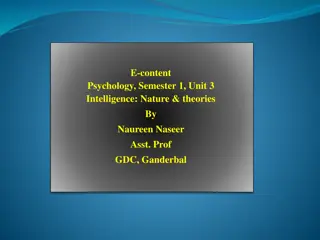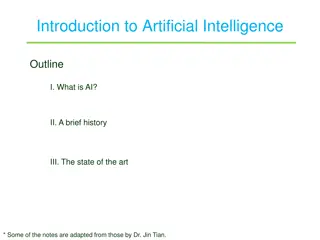Understanding Artificial Intelligence: A Comprehensive Overview
Explore the realm of Artificial Intelligence (AI) through its definitions, historical context, and practical applications. Delve into the core elements of AI, including discerning intelligence, learning, reasoning, and understanding the role of algorithms and specialized hardware in AI performance. Unravel the process of mimicking intelligence through goal-setting, information assessment, data manipulation, and goal refinement, leading to a deeper understanding of AI's capabilities and potential.
Download Presentation

Please find below an Image/Link to download the presentation.
The content on the website is provided AS IS for your information and personal use only. It may not be sold, licensed, or shared on other websites without obtaining consent from the author. Download presentation by click this link. If you encounter any issues during the download, it is possible that the publisher has removed the file from their server.
E N D
Presentation Transcript
Part I Introducing AI Part I Introducing AI Discover what AI can actually do for you. Consider how data affects the use of AI. Understand how AI relies on algorithms to perform useful work. See how using specialized hardware makes AI perform better.
Chapter 1 Introducing AI Chapter 1 Introducing AI Defining AI and its history Using AI for practical tasks Seeing through AI hype Connecting AI with computer technology
Defining the Term AI Defining the Term AI Artificial Intelligence (AI) has had several false starts and stops over the years, partly because people don t really understand what AI is all about, or even what it should accomplish. So, the best way to start this book is to define what AI actually is, what it isn t, and how it connects to computers today.
Discerning intelligence Intelligence involves certain mental activities composed of the following activities: Learning: Having the ability to obtain and process new information Reasoning: Being able to manipulate information in various ways Understanding: Considering the result of information manipulation Grasping truths: Determining the validity of the manipulated information Seeing relationships: Divining how validated data interacts with other data Considering meanings: Applying truths to particular situations in a manner consistent with their relationship Separating fact from belief: Determining whether the data is adequately supported by provable sources that can be demonstrated to be consistently valid
Intelligence often follows a process that a computer system can mimic as part of a simulation: 1. Set a goal based on needs or wants. 2. Assess the value of any currently known information in support of the goal. 3. Gather additional information that could support the goal. The emphasis here is on information that could support the goal, rather than information that you know will support the goal. 4. Manipulate the data such that it achieves a form consistent with existing information.
5. Define the relationships and truth values between existing and new information. 6. Determine whether the goal is achieved. 7. Modify the goal in light of the new data and its effect on the probability of success. 8. Repeat Steps 2 through 7 as needed until the goal is achieved (found true) or the possibilities for achieving it are exhausted (found false). In fact, no computer can fully implement any of the mental activities described in the list that describes intelligence.
Discovering four ways to define AI 1. Acting humanly: When a computer acts like a human, it best reflects the Turing Test, in which the computer succeeds when differentiation between the computer and a human isn t possible. 2. Thinking humanly: When a computer thinks like a human, it performs tasks that require intelligence (as contrasted with rote procedures) from a human to succeed, such as driving a car. 3. Thinking rationally: Studying how humans think using some standard enables the creation of guidelines that describe typical human behaviors. 4. Acting rationally: Studying how humans act in given situations under specific constraints enables you to determine which techniques are both efficient and effective.
The first concept thats important to understand is that AI doesnt really have anything to do with human intelligence. Yes, some AI is modeled to simulate human intelligence, but that s what it is: a simulation. AI relies on algorithms to achieve a result that may or may not have anything to do with human goals or methods of achieving those goals. The Wright Brothers didn t succeed in creating an airplane by precisely copying the flight of birds; rather, the birds provided ideas that led to aerodynamics, which eventually led to human flight. The goal is to fly. Both birds and humans achieve this goal, but they use different approaches.
Understanding the History of AI Understanding the History of AI The desire to create intelligent machines (or, in ancient times, idols) is as old as humans. Starting with symbolic logic at Dartmouth (1956) Continuing with expert systems (1970s) Overcoming the AI winters Machine Learning Deep Learning
Considering AI Uses Considering AI Uses Fraud detection: The AI embedded within the credit card company s code detected an unfamiliar spending pattern and alerted someone to it. Resource scheduling: Many organizations need to schedule the use of resources efficiently Automation: Any form of automation can benefit from the addition of AI to handle unexpected changes or events. Customer service: The customer service line you call today may not even have a human behind it. Safety systems: Many of the safety systems found in machines of various sorts today rely on AI to take over the vehicle in a time of crisis. Machine efficiency: AI can help control a machine in such a manner as to obtain maximum efficiency.
Avoiding AI Hype and Overestimation Avoiding AI Hype and Overestimation The problem is that AI is actually in its infancy, and any sort of application such as those shown in the movies is the creative output of an overactive imagination.
Defining the five tribes and the master algorithm Symbologists: The origin of this tribe is in logic and philosophy. This group relies on inverse deduction to solve problems. Connectionists: This tribe s origin is in neuroscience, and the group relies on backpropagation to solve problems. Evolutionaries: The evolutionaries tribe originates in evolutionary biology, relying on genetic programming to solve problems. Bayesians: This tribe s origin is in statistics and relies on probabilistic inference to solve problems. Analogizers: The origin of this tribe is in psychology. The group relies on kernel machines to solve problems.
The ultimate goal of machine learning is to combine the technologies and strategies embraced by the five tribes to create a single algorithm (the master algorithm) that can learn anything. Of course, achieving that goal is a long way off.
Considering sources of hype There are many sources of AI hype out there. Quite a bit of the hype comes from the media. Some products should be tested a lot more before being placed on the market. Another cause of problems comes from asking the wrong person about AI.
Understanding user overestimation Because of hype (and sometimes laziness or fatigue), users continually overestimate the ability of AI to perform tasks.
Connecting AI to the Underlying Computer Connecting AI to the Underlying Computer To see AI at work, you need to have some sort of computing system, an application that contains the required software, and a knowledge base. The size of the computing system is directly proportional to the amount of work you expect the AI to perform. The application can also vary in size, complexity, and even location. The knowledge base varies in location and size as well. A network connection affords you access to a large knowledge base online but costs you in time because of the latency of network connections. However, localized databases, while fast, tend to lack details in many cases.























